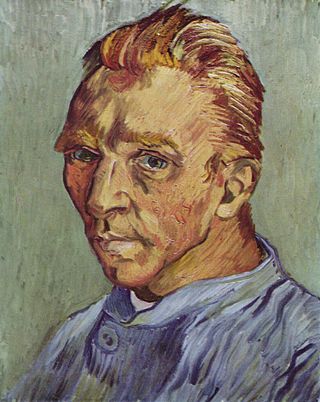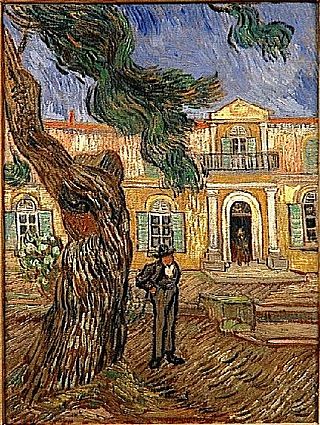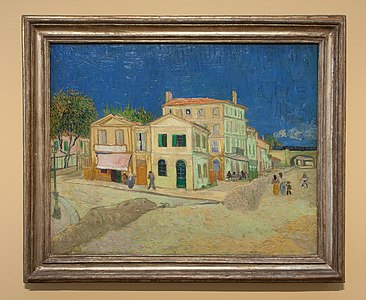
Vincent Willem van Gogh was a Dutch Post-Impressionist painter who is among the most famous and influential figures in the history of Western art. In just over a decade, he created approximately 2100 artworks, including around 860 oil paintings, most of them in the last two years of his life. His oeuvre includes landscapes, still lifes, portraits, and self-portraits, most of which are characterised by bold colours and dramatic brushwork that contributed to the rise of expressionism in modern art. Van Gogh's work was beginning to gain critical attention before he died from a self-inflicted gunshot at age 37. During his lifetime, only one of Van Gogh's paintings, The Red Vineyard, was sold.

The portraits of Vincent van Gogh (1853–1890) include self-portraits, portraits of him by other artists, and photographs—one of which is dubious—of the Dutch artist. Van Gogh's dozens of self-portraits were an important part of his œuvre as a painter. Most probably, van Gogh's self-portraits are depicting the face as it appeared in the mirror he used to reproduce his face, i.e. his right side in the image is in reality the left side of his face.

Sunflowers is the title of two series of still life paintings by the Dutch painter Vincent van Gogh. The first series, executed in Paris in 1887, depicts the flowers lying on the ground, while the second set, made a year later in Arles, shows a bouquet of sunflowers in a vase. In the artist's mind, both sets were linked by the name of his friend Paul Gauguin, who acquired two of the Paris versions. About eight months later, van Gogh hoped to welcome and impress Gauguin again with Sunflowers, now part of the painted Décoration for the Yellow House that he prepared for the guestroom of his home in Arles, where Gauguin was supposed to stay.

Les Alyscamps is a pair of paintings ("pendants") by Dutch painter Vincent van Gogh. Painted in 1888 in Arles, France, it depicts autumnal scenes in the Alyscamps, an ancient Roman necropolis in Arles which is lined with poplars and stone sarcophagi.

Starry Night, commonly known as Starry Night Over the Rhône, is one of Vincent van Gogh's paintings of Arles at night. It was painted on the bank of the Rhône that was only a one or two-minute walk from the Yellow House on the Place Lamartine, which van Gogh was renting at the time. The night sky and the effects of light at night provided the subject for some of van Gogh's more famous paintings, including Café Terrace at Night and the June, 1889, canvas from Saint-Remy, The Starry Night.

Bedroom in Arles is the title given to three similar paintings by 19th-century Dutch Post-Impressionist painter Vincent van Gogh.

L'Arlésienne, L'Arlésienne : Madame Ginoux, or Portrait of Madame Ginoux is the title given to a group of six similar paintings by Vincent van Gogh, painted in Arles, November 1888, and in Saint-Rémy, February 1890. L'Arlésienne means literally "the woman from Arles".
Vincent van Gogh lived during the Impressionist era. With the development of photography, painters and artists turned to conveying the feeling and ideas behind people, places, and things rather than trying to imitate their physical forms. Impressionist artists did this by emphasizing certain hues, using vigorous brushstrokes, and paying attention to highlighting. Vincent van Gogh implemented this ideology to pursue his goal of depicting his own feelings toward and involvement with his subjects. Van Gogh's portraiture focuses on color and brushstrokes to demonstrate their inner qualities and Van Gogh's own relationship with them.

The Roulin Family is a group of portrait paintings Vincent van Gogh executed in Arles in 1888 and 1889 of Joseph, his wife Augustine and their three children: Armand, Camille and Marcelle. This series is unique in many ways. Although Van Gogh loved to paint portraits, it was difficult for financial and other reasons for him to find models. So, finding an entire family that agreed to sit for paintings — in fact, for several sittings each — was a bounty.
Vincent Van Gogh was displayed at the 1890 Les XX exhibition—an invitation-only show exclusively for members—in Brussels, Belgium. This served to demonstrate the recognition Van Gogh received from his avant-garde peers during his life. The choices of his works and their arrangements illustrated his thinking about his years of work in Provence.

Flowering Orchards is a series of paintings which Dutch artist Vincent van Gogh executed in Arles, in southern France in the spring of 1888. Van Gogh arrived in Arles in February 1888 in a snowstorm; within two weeks the weather changed and the fruit trees were in blossom. Appreciating the symbolism of rebirth, Van Gogh worked with optimism and zeal on about fourteen paintings of flowering trees in the early spring. He also made paintings of flowering trees in Saint-Rémy the following year, in 1889.

In May 1890, on his arrival in Auvers-sur-Oise, Vincent van Gogh continued his work mainly with size 30 canvases, and created more than a dozen such paintings.
Wheat Fields is a series of dozens of paintings by Dutch Post-Impressionist artist Vincent van Gogh, products of his religious studies and sermons, connection to nature, appreciation of manual laborers and desire to provide a means of offering comfort to others. The wheat field works demonstrate his progression as an artist from the drab Wheat Sheaves made in 1885 in the Netherlands to the colorful and dramatic 1888–1890 paintings from Arles, Saint-Rémy and Auvers-sur-Oise in rural France.

Vincent van Gogh enjoyed making Paintings of Children. He once said that it's the only thing that "excites me to the depths of my soul, and which makes me feel the infinite more than anything else." Painting children, in particular represented rebirth and the infinite. Over his career Van Gogh did not make many paintings of children, but those he completed were special to him. During the ten years of Van Gogh's career as a painter, from 1881 to 1890, his work changed and grew richer, particularly in how he used color and techniques symbolically or evocatively.

Saint-Paul Asylum, Saint-Rémy is a collection of paintings that Vincent van Gogh made when he was a self-admitted patient at the Saint-Paul asylum in Saint-Rémy-de-Provence, since renamed the Clinique Van Gogh, from May 1889 until May 1890. During much of his stay there he was confined to the grounds of the asylum, and he made paintings of the garden, the enclosed wheat field that he could see outside his room and a few portraits of individuals at the asylum. During his stay at Saint-Paul asylum, Van Gogh experienced periods of illness when he could not paint. When he was able to resume, painting provided solace and meaning for him. Nature seemed especially meaningful to him, trees, the landscape, even caterpillars as representative of the opportunity for transformation and budding flowers symbolizing the cycle of life. One of the more recognizable works of this period is The Irises. Works of the interior of the hospital convey the isolation and sadness that he felt. From the window of his cell he saw an enclosed wheat field, the subject of many paintings made from his room. He was able to make but a few portraits while at Saint-Paul.

Old Church Tower at Nuenen are names given to several oil paintings and drawings created in 1884 and 1885 by Vincent van Gogh. Most reflect the way the 12th-century church looked in its better days when its spire was intact and its foundation formidable. The spire was demolished in 1792 and the church tower was in the process of being torn down and sold for scrap as Van Gogh made the paintings.

Still life paintings by Vincent van Gogh (Paris) is the subject of many drawings, sketches and paintings by Vincent van Gogh in 1886 and 1887 after he moved to Montmartre in Paris from the Netherlands. While in Paris, Van Gogh transformed the subjects, color and techniques that he used in creating still life paintings.

Enclosed Field with Peasant is an oil painting by Dutch artist Vincent van Gogh, painted around 12 October 1889. The Size 30 painting, measuring 73 cm × 92 cm, depicts a scene of a ploughed field near the asylum at Saint-Rémy-de-Provence, with a lilac bush, a peasant carrying a wheatsheaf, several buildings, and the Alpilles mountains rising behind, with a small patch of sky. Van Gogh considered it a pendant painting to The Reaper executed earlier in 1889. It is currently part of the permanent collection at the Indianapolis Museum of Art.

Dutch Post-Impressionist painter Vincent van Gogh painted a self-portrait in oil on canvas in September 1889. The work, which may have been Van Gogh's last self-portrait, was painted shortly before he left Saint-Rémy-de-Provence in southern France. The painting is now at the Musée d'Orsay in Paris.
















































